Tillandsia White Star (Dimmit)
& Tillandsia 'Holm's White Star'
Click thumbnails for full size, scaled to a new window.
Tillandsia 'White Star' (Dimmit)
The cultivar name describes the rosette when viewed from above - tapered grey-green leaves in a symmetrical rosette completely covered in a white scurf, like a slightly less stiff form of T. ixioides. Powdery pink bracts and light yellow flowers, paler in the inflorescence than the reverse cross T. 'Holm's White Star'.
ixioides X recurvifolia, Mark Dimmitt (for Isley RFI), Arizona USA, 1981.
Tillandsia 'Holm's White Star' (Isley)
Mature open rosette to 18 cm. diameter x 10cm. high. Widely recurved, long, channeled leaves which are solid, hard yet flexible, smooth and densely covered with tiny, adpressed silvery-white trichomes, more like T. recurvifolia. The inflorescence with a long arched peduncle has light pink to salmon, scurfy bracts and bears 6-8 yellow flowers. The inflorescence has darker pink bracts and richer yellow flowers than T. 'White Star'
(Dimmitt) with reverse parentage. recurvifolia (formerly meridionalis) x ixioides, Burkhard Holm, Germany, 1995


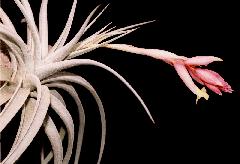
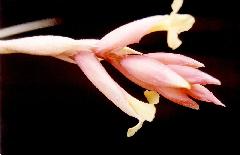
| Ken Woods 11/04 'White Star' |
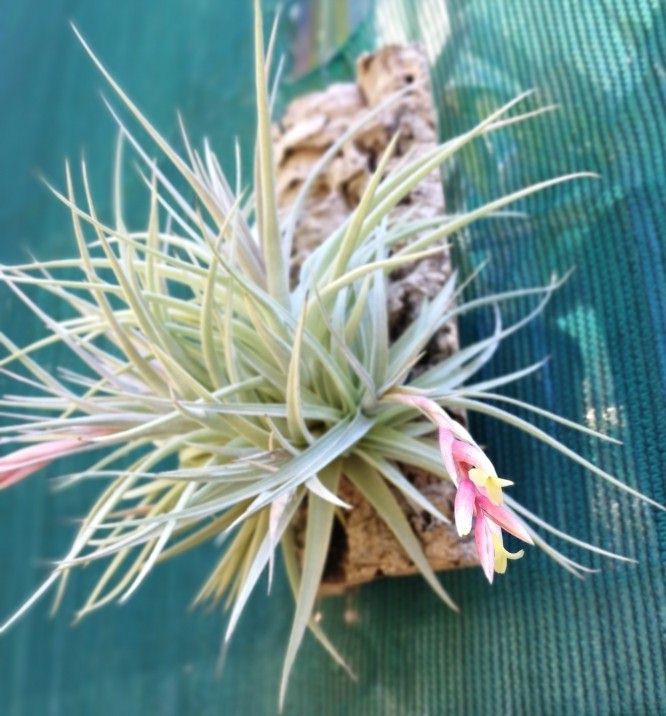
| Justin Lee 03/18 'Holm's White Star' |
Justin Lee ... "This is a nice little Holm hybrid - recurvifolia X ixioides. I must check the BCR to see if it's been given a name."
Geoff Lawn ... "Yes, Justin, it's T. 'Holm's White Star'. See: http://registry.bsi.org/?fields=&id=13886&search=
It's a bit of a misnomer, with no white in it, but so named to distinguish it from the T. White Star (reverse cross) bred by Mark Dimmitt."
Chris Larson ... "The white in Dimmitt's plant, I think, refers to the foliage - as well as the star shaped foliage (coming from ixioides). Holm's plant is actually whiter, but less star shaped."
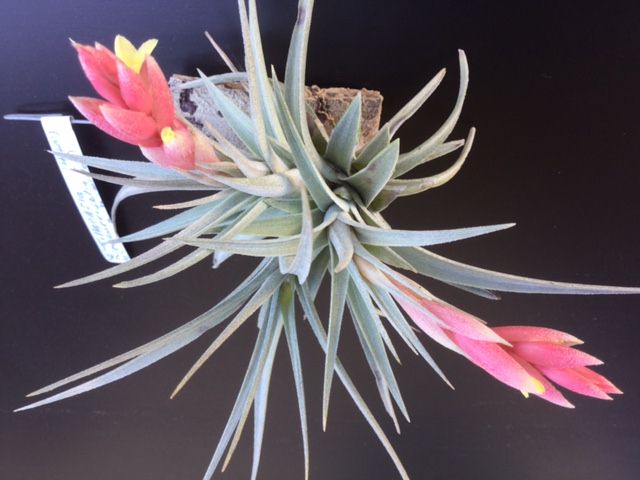

| Ron Jell 09/15 (Reverse Cross, by Holm) |
Derek Butcher 09/15 'White Star' |
Ron Jell 1/9/15 ... "I currently have this Holm hybrid in flower and the colour is really eye catching. I bought it from Peter Tristram in 2013 as T. recurvifolia x ixioides"
Derek Butcher 1/9/15 ... "Ron: Now might be the time to compare it with 'White Star' a reverse cross. To me they look similar despite the variations you can get with T. recurvifolia. As Margaret Paterson points out, with reverse crosses you sometimes get similar progeny and sometimes not, no doubt revolving about dominate genes and other like factors."
Chris Larson 1/9/15 ... "We need to name this one too – I have been referring to it as 'Holm’s White Star' – but I notice that Dimmitts T. 'White Star' is the reverse cross. Everything I’ve parted with has been under formula. It beats T. 'White Star' for foliage colour (is silver a colour?) and flower colour – though the plant seems to pup & flower for me at a small size when grown in a clump."
Ron Jell 2/9/15 ... "Thank you for the 'well grown plant' comments that have been given, much appreciated, I do try very hard to get it right, and I have attached another photo as more flowers have now opened.
Also, UD, I have looked at the reverse cross photos and while my plant is similar to T. 'White Star', but I agree with Chris that Holm's cross has superior foliage and flower colour.
As far as a name is concerned I like Peter's 'Silver Star' suggestion, as in the flesh my plant looks more silver than white and I think this would better describe the plant. However, I did very, very briefly consider Bob and Ian's clever Persil and Etihw Rats."
Geoff Lawn 13/12/16 ... "the T. ixioides x recurvifolia was registered in March, 2002 as T. White Star, bred by Mark Dimmitt (Arizona). See BCR.
There is no BCR record of the reverse cross T. recurvifolia x ixioides, nor any outstanding hybrids to be registered by Holm's daughter Tanja Richter, as far as I know.
Ron, what makes you think what you have is a Holm hybrid ? In Peter Tristram's Master List of imports ex Holm, there is no listing of T. recurvifolia x ixioides. So where did yours originate?"
Derek Butcher 14/12/16 ... "Just another example of not solving a problem when we have the opportunity. A formula denotes a grex and cannot be recorded under the ICNCP rules. I know we are having problems in convincing BSI Judges that a formula does not constitute an identity so how can they possibly judge a plant without a name. I would have thought that members of this Tillandsia discussion group would be more discerning than most growers in trying to get a name recorded.
There is a 'ixioides x meridionalis' on Peter's list and in most cases we can equate meridionalis with recurvifolia. The botanist may disagree with me on this - see Tillandsia recurvifolia Hooker, Bot. Mag. pl. 5246 (1861).
Tillandsia meridionalis sensu Smith & Downs 1977 et auctorum, non Baker 1888.(See Till and Luther in JBS 1995 p264-8)
You can see why I am a doubting Thomas as to how collectors always use the right order when quoting formulas."
Chris Larson 15/12/16 ... "My comments on the 2 plants: They have been discussed here many times before – too many to remember.
The first time I saw Holm’s plant in my collection from a medium distance I thought it was Dimmitt’s T. White Star.
The second time I saw it was when Peter posted a guessing competition on this discussion group & I thought – looks very close to T. White Star, but no it is Holms version.
This is the plant that Tanya says is too close to Dimmitt’s T. White Star & therefore she will be referring to it as 'White Star'. This is in Tanya’s notes that Geoff has somewhere. So yes it has been dealt with.
This plant has substantially softer foliage (taking a lot more of the recurvifolia, where Dimmitt’s takes more of the ixioides). The colour of both the bracts and flower are stronger. I think a major improvement on Dimmitt’s T. White Star.
On the basis of Tanya’s comments, a number of people have it from me as T. Holm’s White Star – or T. White Star (Holm).
For me this plant is much more vigorous and flowers more readily than Dimmitt’s T. White Star."
Geoff Lawn 15/12/16 ... "Hi Chris. So on the basis of your comments, I have emailed Tanja Richter to see if she will reconsider registering her father's remake of T. White Star as T. 'Holm's White Star'. If left not recorded, officially it doesn't exist."
Geoff Lawn 14/12/16 ... "Hi Tanja. The debate is on about your version of T. White Star and nurserymen like Chris Larson are spelling out the differences from Mark Dimmitt's White Star and calling yours T. 'Holm's White Star'. Do you wish to reconsider and register yours as T. 'Holm's White Star' ?"
Tanja Richter 19/12/16 ... "With great interest I read your discussion ! Thank you for including me.
Unfortunately I cannot compare those two cultivars at the living object, I can only compare the picture of the registered T. White Star with our (T. recurvifolia x ixioides). That was registered in Dad's studbook from 1995 as (meridionalis x ixioides) and I agree with Derek that T. meridionalis is now T. recurvifolia.
Chris describes softer foliage and stronger colours, so I think you all are best placed to assess the differences, and if you think that it's good to register our reverse cross , I will certainly do that as soon as possible."
Chris Larson 19/12/16 ... "They are similar, but I have no doubts about which is which – in flower or not, and it is already in collections here under the name T. 'Holm's White Star'"
Peter Tristram 20/12/16 ... "Yes, T. 'Holm's White Star' is a good compromise."
Geoff Lawn 03/02/17 ... "Compared to Mark Dimmitt's T. 'White Star', the reverse cross, German-bred by Burkhard Holm, is now registered as T. 'Holm's White Star', although ironically it has pale yellow flowers. So there shouldn't be any confusion."
Geoff Lawn 03/02/17 ... "Oops, it seems both cultivars have pale yellow flowers with only the degree of inflorescence scurf separating them. T. Yellow Star would have been a better name choice."
Chris Larson 04/02/17 ... "I have several plants from Isley of Dimmitt’s T. White Star – which are a little variable, but not enough to discern between. I also have a couple of Holm’s plants – these are very much the same – though I might have got pups from the same plant.
The shade of pink is darker in Holm’s plant.
The shade of yellow is more rich in Holm’s plant.
Holm’s plant, under my conditions, is a little smaller.
The foliage in Dimmitt’s is like a slightly less stiff form of T. ixioides.
The foliage of Holm’s plant is more toward T. recurvifolia."
Ed: ... Note: Not mentioned above ... T. White Star was probably named for the 'White' appearance of the foliage, not the flower.
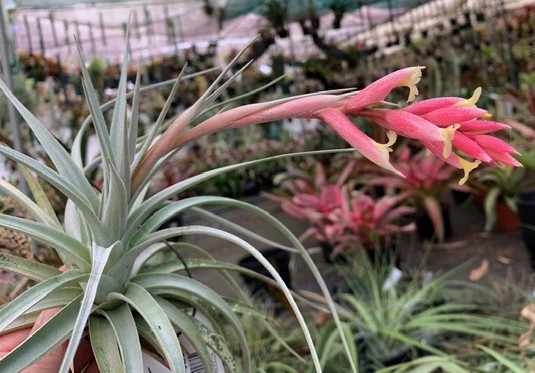

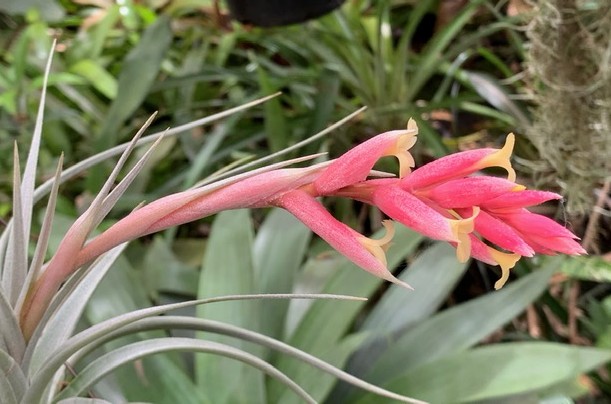
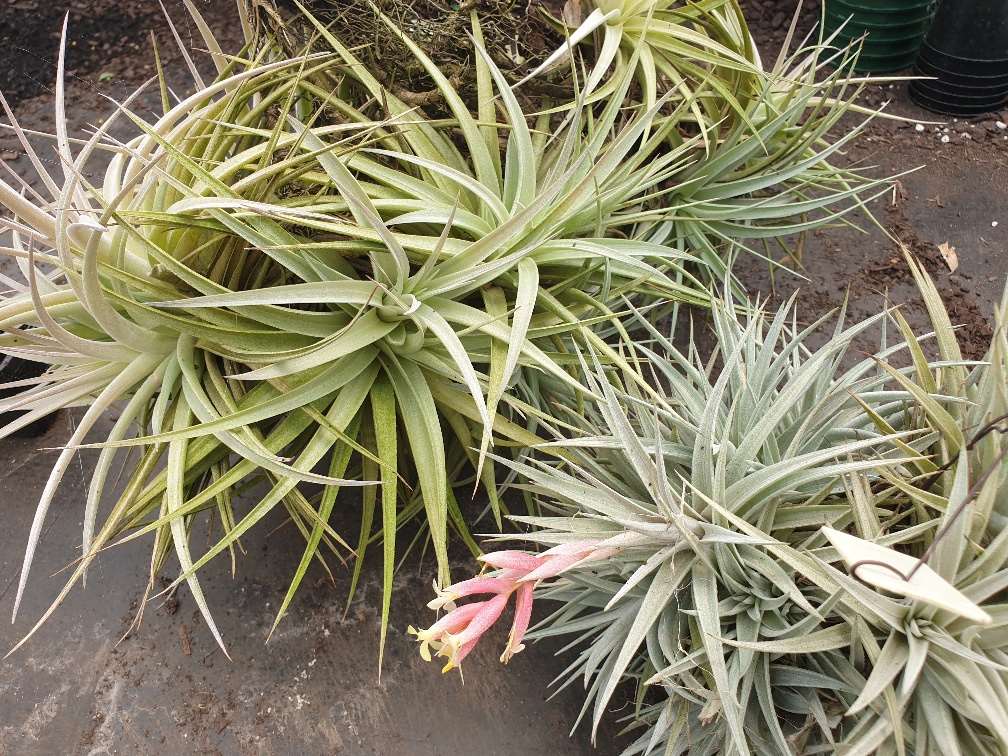
| Peter Tristram 11/20 'Holm's White Star'. ex. Burkhard Holm (Double the size of Isley version) |
Chris Larson 11/20 Isley's at rear, Holm's at front. |
Peter Tristram ... "We’ve discussed this before but there are many new members now so, the question is, how much difference does the clonal form of a parent make in seed raising? The answer is easy! A lot! It doesn’t matter if species or hybrid either. The plant pictured is one I got from Burkhard Holm over 10 years ago, with the same parentage as RFI’s T. White Star. The size difference is the main splitter here with the Holm version at least double the Isley one. It’s registered as T. Holm’s White Star. I'm sure we can assume that Burkhard used at least one bigger parent as both recurvifolia and ixioides come in many sizes. As seed is grown, both inter-species and intra-species, and hybrids are made and remade, the variation will be endless. We have much to look forward to!"
Rob Bower ... "Lovely colours in your plant.
Re the general questions you raise below - my gut feeling is that the looseness of parentage specificity, using different clones to remake crosses, naming seedling grexes as a cv etc is going to lead to a big mess. I guess a beautiful till is still one even if the labelling is confused. Must drive the taxonomists and purists crazy though."
Chris Larson ... "It has taken me a while to reply as I needed the photo attached. Attached it shows the Isley one at the rear, and the Holm one in the foreground. These are grown in the same greenhouse house. Both getting the same (very bright filtered) light, same fert, though watering is likely marginally greater on the Isley one."
Early on (after importation), the Holm one grew big, and had more silver & more colour in the spike/flowers than Isley's - it is still more silver & the spike more colourful. Now Holm's pup, and clump, and flower immaturely. If I separate the pups early I get larger plants, but not like before. But if I leave them in a clump they flower every year - but not at the original size."
I am yet to take them out of the greenhouse and put some of the Holm plant at home to see what happens. (Isley's White Star is one of the hardiest plants I have for Melbourne conditions.) It is strange what culture does to our plants - my mind immediately goes to Rays query about T. ionantha Curly Top. The conditions where the plants of the 2 White Stars in my photo are grown is conditions I would have thought optimal.
Time to move them around and see which conditions produce better results."
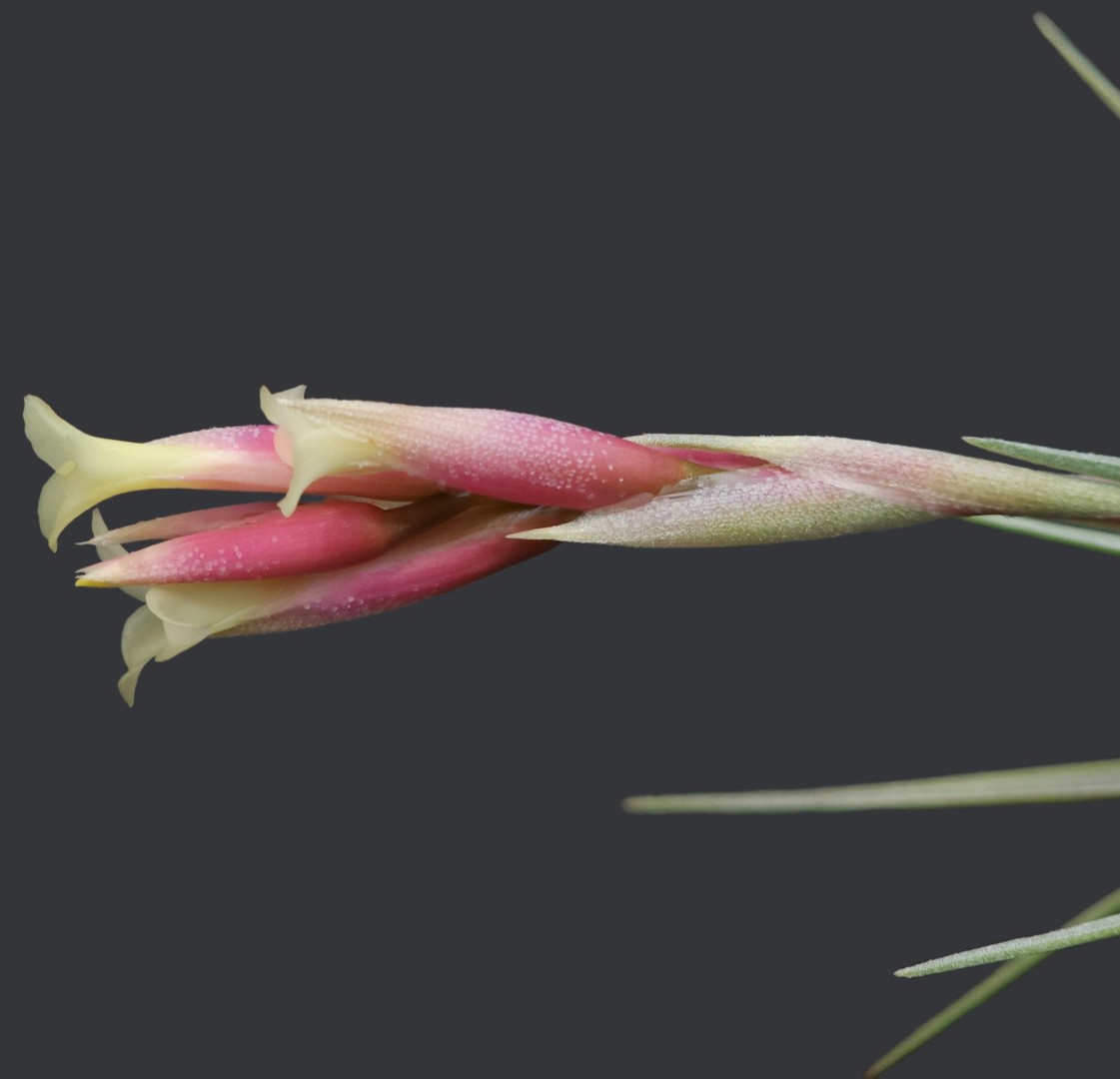
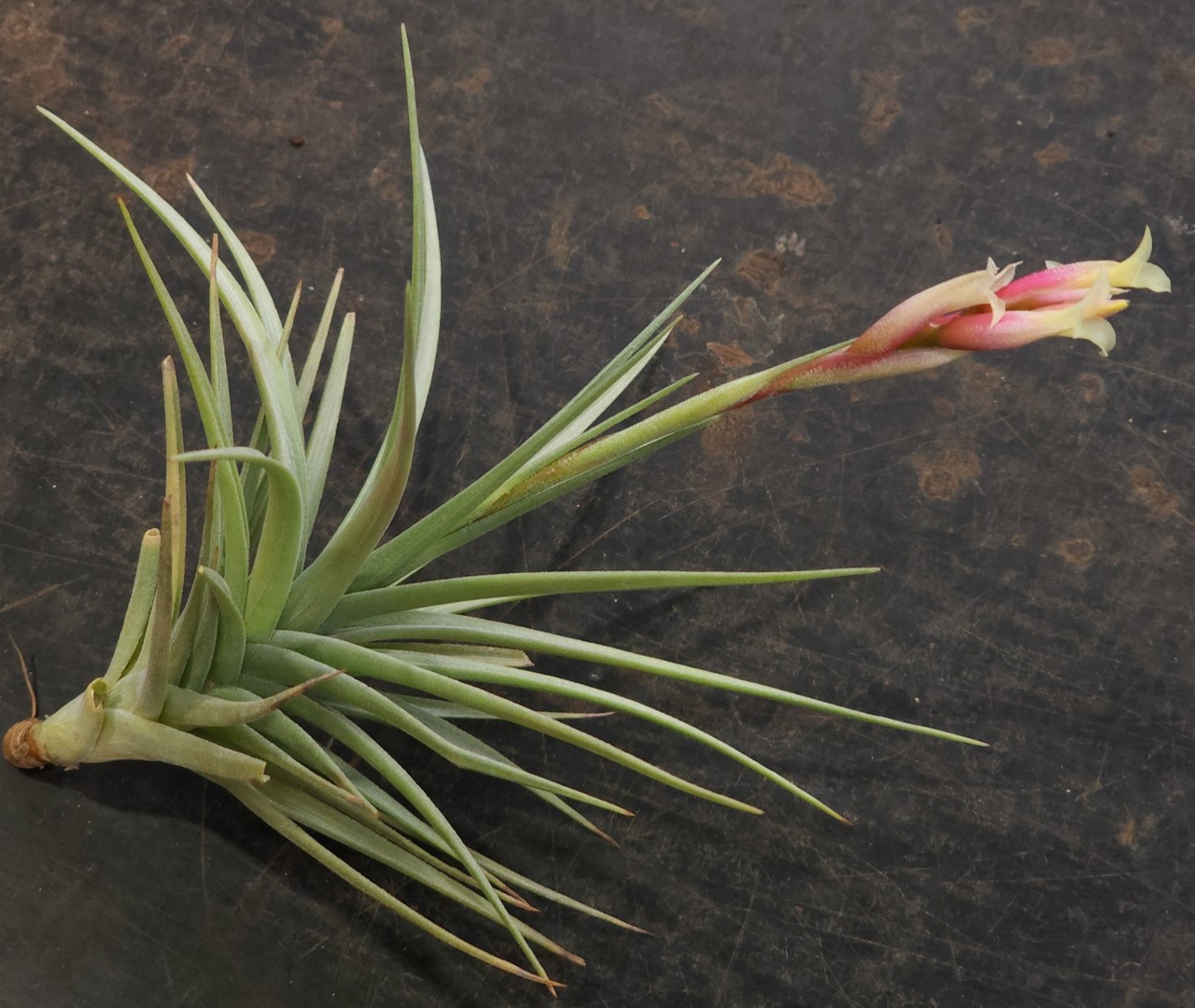
| Chris Larson 02/23. Another new commercial plant. Comes as T. jucunda 'White Star'. In reasonable quantities. Not T. 'White Star'. Probably just a T. jucunda cultivar. |
Ray Clark ... "Hi Chris, dare I say it, your plant does look a lot like the run-of-the-mill jucunda. As you point out, we already have T. 'White Star' and also T. 'Holm's White Star'. Can you see anything unusual or perhaps a variation to warrant a CV name?"





| Bruce Dunstan 07/24 Holm's White Star |
Updated 30/07/24

















